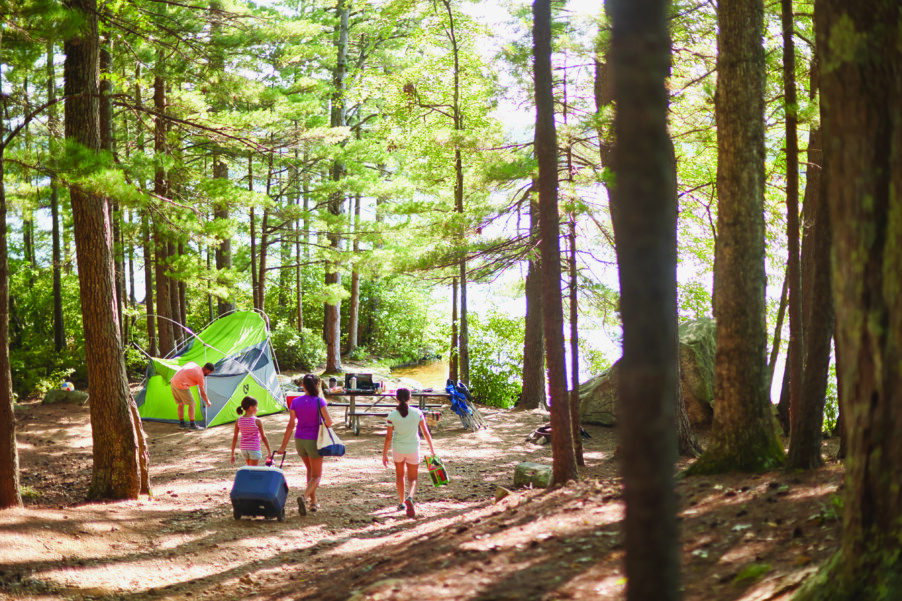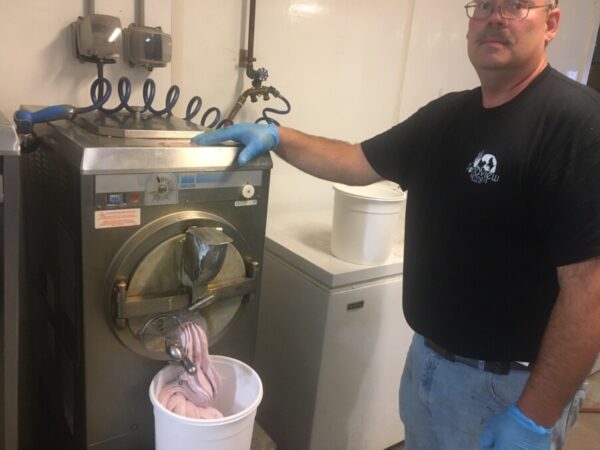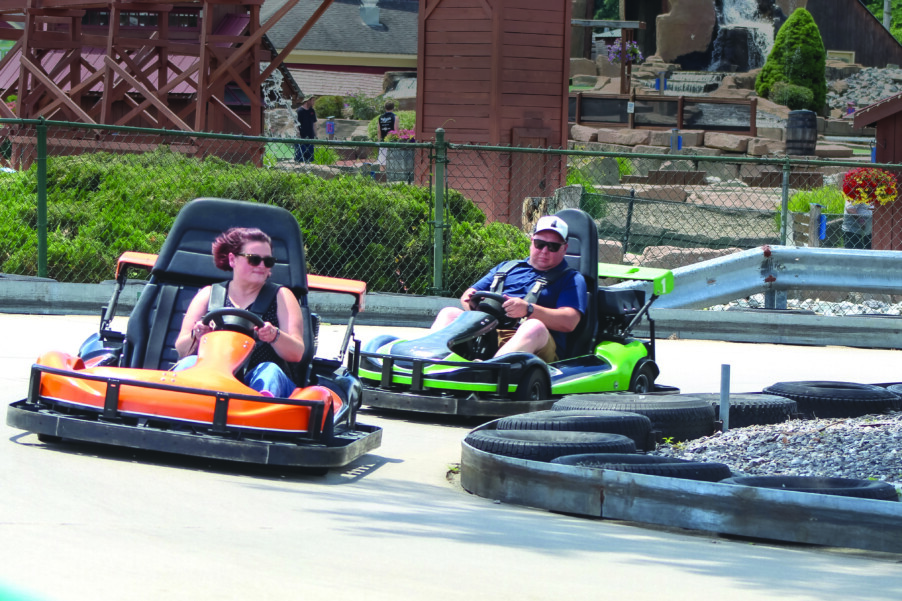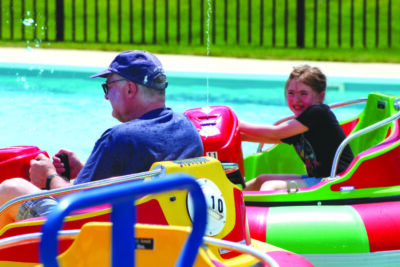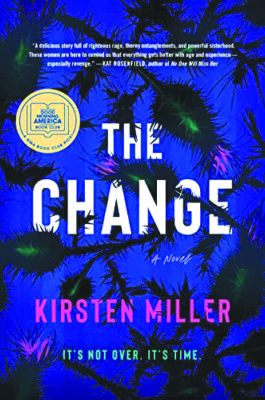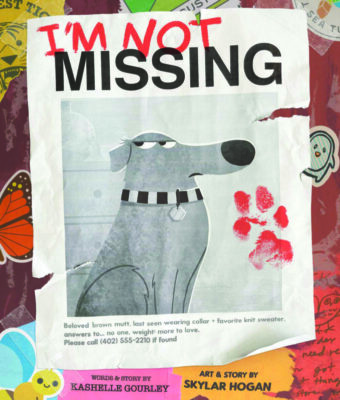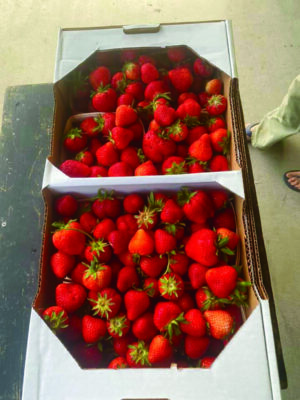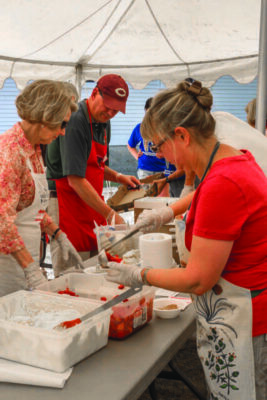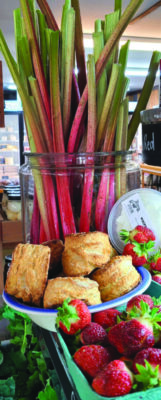Fairs, shows, outdoor adventure and more sunny fun for your chill kids
Fairs and festivals
Catch a town fair, a specialty expo or a local old home day celebration this summer — here’s a list of all those happenings and more set to take place across the Granite State over the next few months. Be sure to visit each event’s or organization’s website or social media pages for the most up-to-date details.
• The Nashua Parks and Recreation department kicks off its Summer Fun schedule of events on Saturday, June 18, from 10 a.m.. to 1 p.m. with Celebrating DPW Day in Greeley Park (100 Concord St. in Nashua), featuring live music (including Joe Birch at 10:15 a.m.), BJ Hickman Magic Show at 11:15 a.m., local stage acts, a bounce house, vendors and more. SummerFun highlights include a Silver Knights baseball game on Monday, July 4, at 11 a.m. when kids 12 and under get in free, and the evening includes the Spartans Drum and Bugle Corp and fireworks; family field day at the library on Thursday, July 14, at 2 p.m.; a Fairy Tale Festival in Greeley Park on Saturday, July 30, from 10 a.m. to 1 p.m. featuring a costume parade, and Wheels & Wings at the Nashua Airport on Saturday, Sept. 17. Nashua also will host several Pics in the Park at Greeley Park (100 Concord St. in Nashua): Jurassic Park (PG-13, 1993) on Friday, July 15, at dusk; Raiders of the Lost Ark (PG-13, 1981) on Friday, Aug. 12, at dusk, and Shrek (PG, 2001) on Friday, Sept. 16, at dusk. And the city hosts several outdoor concerts throughout the summer. See nashuanh.gov.
• The 40th annual Somersworth International Children’s Festival is happening on Main Street and Noble Pines Park in Somersworth on Saturday, June 18, from 10 a.m. to 3 p.m. Enjoy live music, food, local vendors, rides, wildlife encounters and a variety of other children’s activities, including — new this year — a Touch-A-Truck area. A pre-festival celebration will take place the night before, on Friday, June 17, from 6 to 10 p.m. at Somersworth High School (11 Memorial Drive), and will include a fireworks display. Visit nhfestivals.org.
• Plaistow’s Old Home Day will be held on Saturday, June 18 — activities will take place from 9 a.m. to 3 p.m. on the Town Hall green (145 Main St., Plaistow) and will include demonstrations, contests, a parade, a road race, raffles, fireworks and more. Find them on Facebook @plaistowoldhomeday for updates.
• Intown Concord’s annual Market Days Festival, a three-day free street festival, is set to return to Main Street in downtown Concord from Thursday, June 23, through Saturday, June 25. Visit marketdaysfestival.com for the full list of happenings, which will include live music, a beer tent, participating local vendors, children’s activities and giveaways. The “KidZone” will be open each day from 10 a.m. to 8 p.m. on the Statehouse lawn and will feature two bounce houses this year, as well as hula hoops, cornhole, jenga and other games.
• The Wilton Main Street Association will present its annual SummerFest on Saturday, June 25 — a full day of festivities is planned across town, including a pancake breakfast, live music, street vendors, an arts market and fireworks in the evening on Carnival Hill. See visitwilton.com/summerfest for the full schedule.
• The next New England Reptile Expo is scheduled for Sunday, June 26, from 9 a.m. to 4 p.m. at the DoubleTree by Hilton Manchester Downtown (700 Elm St., Manchester). The event features thousands of reptiles on display and for sale as pets, plus vendors selling cages, supplies, frozen feeder rodents and other reptile-related items. Admission is $10 for adults, $5 for kids ages 7 to 12 and free for kids under 7. Visit reptileexpo.com.
• Fathom Events (Fathomevents.com) and GKids present Studio Ghibli Fest 2022 kicks off with The Cat Returns (G, 2002) screening Sunday, June 26 (Cinemark Rockingham Park om Salem) and Monday, June 27 (Cinemark Rockingham Park and O’neil Cinemas Brickyard Square in Epping). Hayao Miyazaki’s Kiki’s Delivery Service (G, 1989) will screen at Cinemark Rockingham Park on Sunday, July 31; Monday, Aug. 1, and Wednesday, Aug. 3. Only Yesterday (PG, 1991) will screen Sunday, Aug. 28 (Cinemark Rockingham Park) and Monday, Aug. 29 (Cinemark Rockingham Park and O’neil Cinemas at Brickyard Square).
• O’neil Cinemas at Brickyard Square (24 Calef Hwy. in Epping; 679-3529, oneilcinemas.com) will feature family-friendly films on Mondays and Wednesdays at 10 a.m. starting on Monday, July 4. According to the website, the lineup includes Trolls World Tour (PG, 2020) on July 4 and July 6; Hotel Transylvania: Transformania (PG, 2022) on July 11 and July 13; The Croods: A New Age (PG, 2020) on July 18 and July 20); Minions (PG, 2015) on July 25 and July 27, and The Boss Baby: Family Business (PG, 2021) on Aug. 1 and Aug. 3, and Sing 2 (PG 2021) on Aug. 8 and Aug. 10.
• The Hillsborough Summer Festival, returning to Grimes Field (29 Preston St., Hillsborough) from Thursday, July 7, through Sunday, July 10, features live entertainment, midway and carnival rides, a fireworks show, a 5K road race, a parade, a car and truck show and more. Festival hours are from 6 to 10 p.m. on Thursday, from 5 to 11 p.m. on Friday, from noon to 11 p.m. on Saturday and from noon to 5 p.m. on Sunday. Admission is free — go to hillsborosummerfest.com for the full schedule of happenings.
• The Raymond Town Fair returns from Friday, July 8, through Sunday, July 10, at the Raymond Town Common. Enjoy a firemen’s parade, sack races, pie eating, live music, a fireworks display and more. Fair hours are from 5 to 10 p.m. on Friday, from 10 a.m. to 10:30 p.m. on Saturday and from 10 a.m. to 4 p.m. on Sunday. Visit raymondareanews.com.
• In lieu of the Stratham Fair, which was canceled earlier this year, a new one-day community event known as the Stratham 4-H Summerfest is being planned for Saturday, July 16, at the Stratham Hill Park Fairgrounds (270 Portsmouth Ave., Stratham). The smaller event will feature a single-day family experience, showcasing several 4-H programs and livestock, along with forestry and tractor driving contests, club displays, a teen talent fair and a limited menu of food offerings. Email [email protected] for more details.
• Save the date for the 32nd annual American Independence Festival, happening at the American Independence Museum (1 Governors Lane, Exeter) on Saturday, July 16, from 10 a.m. to 4 p.m. The event features several historical reenactments, colonial artisan demonstrations and children’s activities. Visit independencemuseum.org.
• Don’t miss the Canterbury Fair, returning on Saturday, July 30, at Canterbury Center (Baptist and Center roads). A full day of festivities is planned, from hands-on demonstrations from local artisan and antique vendors to live music, children’s activities and more. Visit canterburyfair.com.
• Concord’s National Night Out Against Crime is on Tuesday, Aug. 2, from 5 to 8 p.m. in Rollins Park (33 Bow St. in Concord) and will feature food, prizes, K-9 demonstrations, Touch-a-Truck, a zoo exhibit, a rock climbing wall and more according to concordnh.gov.
• The Suncook Valley Rotary’s Hot Air Balloon Rally will take place Friday, Aug. 5, through Sunday, Aug. 7, in Pittsfield with a craft fair, a 5K, helicopter rides, a regatta and more. See suncookvalleyrotary.org.
• The Belknap County Fair is scheduled to return on Saturday, Aug. 6, and Sunday, Aug. 7, from 9 a.m. to 5 p.m. each day, at 174 Mile Hill Road in Belmont. The fair features animal shows, demonstrations, live entertainment, exhibits and food. Admission at the gate is $10 for adults, $5 for seniors over 65 and for police, fire and EMS personnel, and free for kids under 10 and for military service members. Visit bcfairnh.org.
• Hudson’s Old Home Days return to the grounds outside the Hills House (211 Derry Road, Hudson) from Thursday, Aug. 11, through Sunday, Aug. 14 — hours are from 5 to 10 p.m. on Thursday, from 5 to 11 p.m. on Friday, from noon to 11 p.m. on Saturday and from noon to 5 p.m. on Sunday. Festivities include free children’s games, live music, carnival games, a fireworks display, fair food and more. Visit hudsonoldhomedays.com.
• The Great New England BBQ & Food Truck Festival returns to the Hampshire Dome (34 Emerson Road, Milford) for its fifth year on Saturday, Aug. 13, from 11 a.m. to 6 p.m. The event will feature a variety of local food trucks, plus artisan vendors, a beer tent, a cornhole tournament, a kids zone, live music and more. Advance tickets are $5 and are available now. Kids ages 14 and under are free. Visit gnecraftartisanshows.com.
• Windham High School (64 London Bridge Road) is scheduled to host a food truck festival on Sunday, Aug. 14, from 11:30 a.m. to 4:30 p.m. Visit windhamnh.gov.
• Catch the 15th annual Hampton Beach Children’s Festival, happening during the week of Monday, Aug. 15, through Friday, Aug. 19, during which there will be magic shows, a costume parade, dancing, storytellers, balloons, ice cream and more. All activities are free and open to the public. Visit hamptonbeach.org.
• Londonderry’s Old Home Days, set for Wednesday, Aug. 17, through Sunday, Aug. 22, are coinciding with the town’s 300th anniversary celebration this year. Several days’ worth of happenings are planned, including a parade, local vendor booths, games, food and much more. Follow the Facebook page @townoflondonderryoldhomeday for updates.
• Formerly known as the Living History event, History Alive will return to various locations in Hillsborough, rain or shine, on Saturday, Aug. 20, and Sunday, Aug. 21, from 9 a.m. to 4 p.m. Also coinciding with the town’s 250th anniversary celebration this year, History Alive will feature several historical reenactments throughout the weekend, plus children’s activities, crafts, speakers, musicians and much more. Admission is $10 for adults and free for kids under 16. Visit historyalivenh.org.
• Don’t miss the annual Candia Old Home Day celebration, happening on Saturday, Aug. 27, from 11 a.m. to 2 p.m. at Moore Park (74 High St., Candia) and featuring a parade, local vendors and live entertainment. Visit candiaoldhomeday.com.
• Join Field of Dreams Community Park (48 Geremonty Drive, Salem) for its annual family fun day event, scheduled for Saturday, Aug. 27, from 11 a.m. to 4 p.m., when there will be local vendors, children’s games, face painting, a touch-a-truck, live music, food trucks and — new this year — a rock climbing wall. Visit fieldofdreamsnh.org.
• A Labor Day weekend tradition, the Hopkinton State Fair will return to the fairgrounds (392 Kearsarge Ave., Contoocook) from Thursday, Sept. 1, through Sunday, Sept. 5. Fair hours are from 5 to 10 p.m. on Thursday, from 8 a.m. to 11 p.m. on Friday, Saturday and Sunday, and from 8 a.m. to 7 p.m. on Monday — the multi-day event features everything from local vendors and classic fair food to live music, carnival rides, agricultural exhibits and demonstrations and more. One-day admission passes are $14 for adults, $12 for seniors over 60, $8 for kids ages 3 to 12 and free for kids ages 3 and under. Five-day passes are also available at a rate of $39 for both kids and adults. Visit hsfair.org.
back to top
Live entertainment
• The Palace Teen Apprentice Company presents Seussical Jr. at the Palace Theatre (80 Hanover St., Manchester) on Wednesday, June 15, and Thursday, June 16, at 7 p.m. Tickets cost $12 to $15. Visit palacetheatre.org or call 668-5588.
• See Blippi The Musical at the Capitol Center for the Arts (44 S. Main St., Concord) on Friday, June 17, at 6 p.m. Tickets cost $39.50 to $59.50. Visit ccanh.com or call 225-1111.
• The North Country Center for the Arts presents its IMPACT series, a six-week tour of performances by a children’s theater troupe, at the Bank of NH Stage (16 S. Main St., Concord) on Tuesdays at 10 a.m., from July 5 through Aug. 9. It kicks off with Sleeping Beautyon July 5, followed by Lost in Wonderlandon July 12, Neverland on July 19, Little Red Riding Hoodon July 26, Return to Oz on Aug. 2 and Jack & the Beanstalkon Aug. 9. Tickets are free. Visit ccanh.com.
• The 2022 Bank of New Hampshire Children’s Summer Series presents a series of shows at the Palace Theatre (80 Hanover St., Manchester) with a Tuesday-through-Friday run every week in July and August. Shows include magician BJ Hickman July 5 through July 8; Wizard of OzJuly 12 through July 15; RapunzelJuly 19 through July 22; Peter PanJuly 26 through July 29; Cinderella Aug. 2 through Aug. 5; Beauty and the Beast Aug. 9 through Aug. 12; Snow White and the Seven Dwarfs Aug. 16 through Aug. 19; and Disney’s Frozen Kids Aug 23 through Aug. 26. Showtimes are at 10 a.m. and 6:30 p.m. from Tuesday through Thursday, and at 10 a.m. on Friday. Tickets cost $10. Visit palacetheatre.org or call 668-5588.
• The Majestic Theatre presents Big The Musical at the Derry Opera House (29 W. Broadway, Derry) from July 8 through July 17, with showtimes on Friday and Saturday at 7 p.m., and Sunday at 2 p.m. Tickets cost $20 for adults and $15 for youth and seniors. Visit majestictheatre.net or call 669-7649.
. • Camp ENCORE presents Disney’s The Little Mermaid Jr. at the Prescott Park Arts Festival (105 Marcy St., Portsmouth) on Saturday, July 9, and Sunday, July 10, at 10 a.m. Reserved seating tickets cost $40. Visit prescottpark.org or call 436-2848.
• The Peterborough Players (55 Hadley Road, Peterborough) second company presents an outdoor performance of The Emperor’s New Clothes on Fridays, July 15, July 29, and Aug. 12; Saturdays, July 16 through Aug. 13; and Wednesdays, July 27 and Aug. 10, at 10:30 a.m. Tickets cost $15 for adults and $10 for children. Visit peterboroughplayers.org.
• Johnny Peers & the Muttville Comix, a slapstick comedy act with more than a dozen performing dogs, comes to the Lakeport Opera House (781 Union Ave., Laconia) on Sunday, July 17, at 2:30 p.m. Tickets start at $25. Visit lakeportopera.com or call 519-7506.
• The Franklin Area Children’s Theatre presents a theatrical adaptation of The Rainbow Fish at the Franklin Opera House (316 Central St., Franklin) on Thursday, July 21, with showtimes at 1 and 7 p.m. Tickets cost $8 for children, $9 for seniors and students and $10 for adults. Call 934-1901 or visit franklinoperahouse.org.
• The Sound of Music will run at the Rochester Opera House (31 Wakefield St., Rochester) from July 29 through Aug. 21. Visit rochesteroperahouse.com or call 335-1992.
• Disney cover band The Little Mermen comes to the Lakeport Opera House (781 Union Ave., Laconia) on Sunday, July 31, at 3 p.m. Come dressed as your favorite Disney character for a chance to win a prize. Tickets start at $30. Visit lakeportopera.com or call 519-7506.
• Chinese acrobatics group The Peking Acrobats will perform at the Lakeport Opera House (781 Union Ave., Laconia) on Thursday, Aug. 4, at 7 p.m., and Friday, Aug. 5, at 8 p.m. Tickets start at $45. Visit lakeportopera.com or call 519-7506.
• The Northeastern Ballet Theatre presents Swan Lake at the Capitol Center for the Arts (44 S. Main St., Concord) on Friday, Aug. 5, and Saturday, Aug. 6, at 7 p.m. Tickets cost $42. Visit ccanh.com or call 225-1111.
• The Peacock Players youth theater company presents Disney’s The Little Mermaid Jr. at the Court Street Theatre (14 Court St., Nashua) from Aug. 5 through Aug. 14, with showtimes on Friday at 7 p.m., Saturday at 2 and 7 p.m., and Sunday at 2 p.m. Visit peacockplayers.org.
• Children’s musician Laurie Berkner will perform a “Greatest Hits Show” at the Tupelo Music Hall, (10 A St., Derry) on Saturday, Aug. 6, at 11 a.m. Tickets cost $25 to $35. VIP tickets, which include counter seats, an after-show meet-and-greet and a photo op, cost $100. Visit tupelomusichall.com.
• Seussical the Musical comes to the Colonial Theatre (609 Main St., Laconia), with showtimes on Friday, Aug. 12, and Saturday, Aug. 13, at 7:30 p.m., and Sunday, Aug. 14, at 2 p.m. Tickets purchased before Aug. 7 cost $16 for youth age 18 and under, $18 for seniors and $20 for adults. Tickets purchased Aug. 7 and after cost $18 for youth, $20 for seniors and $22 for adults. Visit coloniallaconia.com.
• The Winnipesaukee Playhouse (33 Footlight Circle, Meredith) presents Oliver! from Aug. 18 through Sept. 3, with showtimes Tuesday through Saturday at 7:30 p.m., plus matinees on Saturday, Aug. 20; Thursdays, Aug. 25 and Sept. 1; and Tuesday, Aug. 30, at 2 p.m. Tickets cost $25 to $42. Visit winnipesaukeeplayhouse.org.
• The Franklin Area Children’s Theatre presents The Lion King Experience Jr. at the Franklin Opera House (316 Central St., Franklin) on Friday, Aug. 19, and Saturday, Aug. 20, at 7 p.m. Tickets cost $12 for adults and $10 for students, children and seniors. Call 934-1901 or visit franklinoperahouse.org.
• The Riverbend Youth Company presents Shrek the Musical at the Amato Center for the Performing Arts (56 Mont Vernon St., Milford) from Friday, Aug. 26, through Sunday, Aug. 28. More information is TBA. Visit svbgc.org/amato-center.
back to top
Outdoor fun
See a baseball game, attend a car show, or find other fun ways to get outside this summer on this list below.
• The New Hampshire Fisher Cats, the Double-A minor-league affiliate of the Toronto Blue Jays of Major League Baseball, are in the middle of a homestand against the Somerset Patriots. Catch them at Northeast Delta Dental Stadium (1 Line Drive, Manchester) on Thursday, June 16, at 6:35 p.m.; on Friday, June 17, (Marvel’s Defenders of the Diamond night) or Saturday, June 18, (featuring post game fireworks) at 7:05 p.m.; or on Sunday, June 19, at 1:35 p.m. Then, after a day off on Monday, the Fisher Cats will host a six-game series against the Altoona Curve from Tuesday, June 21, through Sunday, June 26. The team’s final home game of the season will be on Sunday, Sept. 18, against the Harrisburg Senators. In addition to post game fireworks on some nights, other special events to look out for include North Woods Law night (July 8), Christmas in July (July 22), Star Wars Night (July 23), Cats-Con Night (Aug. 6), Princesses in the Park (Aug. 7) and Wizards & Wands night (Sept. 3). Visit nhfishercats.com.
• The Nashua Silver Knights of the Futures Collegiate Baseball League recently kicked off their 2022 season and will next play at Holman Stadium (67 Amherst St., Nashua) on Thursday, June 16, at 6 p.m. against the Brockton Rox. Upcoming theme days include Kids Club Sunday on Sunday, June 19, and Scout Night on Friday, June 24. The team’s last home game is on Sunday, Aug. 7, at 3 p.m. against the Worcester Bravehearts. Visit nashuasilverknights.com.
• Don’t miss the 22nd annual Hampton Beach Master Sand Sculpting Classic, happening from Thursday, June 16, through Saturday, June 18. The event features multiple award ceremonies, with prizes given out for the best sand sculptures, along with a fireworks display at 9:30 p.m. on Saturday. The sculptures will then be lighted for nightly viewing through June 26. Visit hamptonbeach.org.
• The Merrimack Parks & Recreation Movies in the Park series kicks off Saturday, June 18, with a screening of Encanto (PG, 2021) at 8:30 p.m. The lineup also includes Spider-Man: No Way Home (PG-13, 2021) on Saturday, July 23, at 8:15 p.m. and Sing 2 (PG, 2021) on Saturday, Sept. 3, at 7:30 p.m. Admission is free and open to Merrimack residents and non-residents. Screenings are held in Wasserman Park (116 Naticook Road in Merrimack). See merrimackparksandrec.org.
• Join the Aviation Museum of New Hampshire (27 Navigator Road, Londonderry) for its annual “Welcome Summer” Fly-In BBQ on Saturday, June 18, from 10 a.m. to 2 p.m. at Boire Field, at the hangar of Nashua Jet Aviation (83 Perimeter Road, Nashua). Pilots are invited to fly in, and vintage airplanes and home-built aircraft are especially welcome. A barbecue buffet will be served at noon — the meal will include chicken, pulled pork, baked beans, salad, pasta, desserts and drinks. Tickets are $30 for adults, $25 for museum members, $10 for kids ages 6 to 12 and free for kids ages 5 and under. Visit nhahs.org.
• The second annual Chandler’s Ball 3-on-3 Kids Basketball Tournament is happening on Saturday, June 18, from 2 to 6 p.m. at Emmett-Sheridan Park (324 Beech St., Manchester). The cost is $15 per team, and players will be divided into age groups of 8 to 12, 13 to 16 and 17 to 21 years old. Visit chandlersangels.org.
• Beaver Brook Association is hosting Strawberry Station: A Family Event at Brown Lane Barn (52 Brown Lane, Hollis) on Sunday, June 19, from 1 to 3 p.m. Learn to spot wild strawberries and make strawberry shortcake. The cost is $45; children are free, but attendees must register in advance. Visit beaverbrook.org.
• Squam Lakes Natural Science Center (Curry Place, 846 Route 3, Holderness) will hold its StoryWalk Kickoff Reception: The Bugliest Bug, on Friday, June 24, from 10 to 11:30 a.m. Stroll along the path that surrounds the Holderness Town Gazebo while reading The Bugliest Bug by Carol Diggory Shields, posted one page at a time along the trail. The story is about the news of a big contest taking place in the land of insects. After the kickoff reception, the trail will be open daily through Sept. 6.
• Dozens of high school football players from across the state will participate in this year’s CHaD NH East-West High School All-Star Football Game, scheduled for Saturday, June 25, at 1 p.m. at Saint Anselm College (100 St. Anselm Drive, Manchester). General admission tickets are $15, with all proceeds benefiting Children’s Hospital at Dartmouth-Hitchcock (CHaD). Visit chadkids.org.
• The Prescott Park Arts Festival has movies on the schedule for screening in Prescott Park in Portsmouth (prescottpark.org). A $5 per person donation is suggested to make a reservation (with other options for a table or blanket). The Monday Night Movie Series kicks off on Monday, June 27, at 8:30 p.m. with a screening of The Perks of Being a Wallflower (PG-13, 2012). The rest of the lineup includes Encanto (PG, 2021) on Monday, July 11, at 8:30 p.m.; Star Wars: The Empire Strikes Back (PG, 1980) on Monday, July 18, at 8:30 p.m.; Moonrise Kingdom (PG-13, 2012) on Monday, July 25, at 8:30 p.m.; Clue (PG, 1985) on Monday, Aug. 1, at 8:30 p.m.; Grease: Sing-Along (1978) on Monday Aug. 8, at 8:30 p.m.; Hook (PG, 1991) on Monday, Aug. 22, at 8:30 p.m., and The Wizard of Oz (1939) on Monday, Aug. 29, at 8:30 p.m.
• Join the New Hampshire Farm Museum (1305 White Mountain Hwy., Milton) for Fourth on the Farm, happening on Saturday, July 2, from 10 a.m. to 4 p.m., during which there will be historical reenactments, a reading of the Declaration of Independence, lawn games, tractor rides, strawberry shortcake and more. Museum admission is $10 for adults, $7.50 for seniors over 65, $5 for kids and teens ages 4 to 17 and free for kids under 4 and for members and active military servicemen and women. Visit nhfarmmuseum.org.
• If you spend a summer Monday at the beach, finish your day at the coast with Movie Night Mondays on Hampton Beach (next to the playground) starting July 11 at dusk (approximately 8:22 p.m. for that first movie and then a few minutes earlier for each subsequent film). The films run weekly through Aug. 29, admission is free, bring a chair or blanket. The lineup of family-friendly films kicks off with Paw Patrol (G, 2021) on July 11. See hamptonbeach.org for the full schedule and the approximate dusk times; rain days are Tuesdays.
• It’s NASCAR Weekend at New Hampshire Motor Speedway (1122 Route 106, Loudon) from Friday, July 15, through Sunday, July 17 — weekend happenings include Friday Night Dirt Duels on Friday, a 200-lap NASCAR Xfinity Series race at 2:30 p.m. on Saturday, followed by the Whelen Manufactured in America 100 NASCAR Whelen Modified Tour race at 6 p.m. on Sunday, the Ambetter 301 will kick off at 3 p.m. Adult tickets start at $49 while kids ages 12 and under are $10. Visit nhms.com.
• The Aviation Museum of New Hampshire (27 Navigator Road, Londonderry) will hold its annual classic car show on Saturday, July 16, from 10 a.m. to 2 p.m. See a wide variety of cars on display, along with restored antique fire trucks courtesy of Amoskeag Reserve Engine Co. Trophies will be given out for the People’s Choice and Museum awards, and the show will also include a 50/50 raffle, food trucks and more. Admission to participate in the show is $10 per vehicle, while for spectators it’s $5 for adults and free for kids ages 12 and under (admission is cash only). Visit nhahs.org.
• Old Stage & Tavern Day is scheduled for Saturday, July 23, from 10 a.m. to 4 p.m. at the New Hampshire Farm Museum (1305 White Mountain Hwy., Milton). Experience what it was like to travel by stagecoach in the 1800s, then tour the museum’s historic Jones farmhouse with guides in period dress. There will also be tractor rides, and candle making and basket making demonstrations, along with a scavenger hunt with prizes awarded. Museum admission is $10 for adults, $7.50 for seniors over 65, $5 for kids and teens ages 4 to 17 and free for kids under 4 and for members and active military servicemen and women. Visit nhfarmmuseum.org.
• The New Hampshire Farm Museum (1305 White Mountain Hwy., Milton) will host a special Truck and Tractor Day on Saturday, Aug. 20, from 10 a.m. to 4 p.m., during which there will be a large display of trucks, tractors, wagons and antique cars dating back to the mid-1900s. Tractor rides will be available around the farm for attendees to visit with the resident cows, sheep, goats, horses, rabbits and chickens. Museum admission is $10 for adults, $7.50 for seniors over 65, $5 for kids and teens ages 4 to 17 and free for kids under 4 and for members and active military servicemen and women. Visit nhfarmmuseum.org.
• Firefighters and police officers from across the Granite State will renew their friendly rivalry during the annual Battle of the Badges Baseball Classic, scheduled for Friday, Aug. 26, at 6:30 p.m. at Northeast Delta Dental Stadium (1 Line Drive, Manchester). Visit chadkids.org.
• One of the largest car shows in the area, Cruising Downtown is scheduled to return to the streets of downtown Manchester for its 21st year on Saturday, Sept. 3. Visit manchesterrotary.com for updates.
back to top
Art & Museums
• The American Independence Museum (1 Governors Lane, Exeter, 772-2622, independencemuseum.org) is a place for people of all ages to learn about America’s revolutionary history. It provides access to historic buildings and interactive, historically accurate depictions of what life was like during the American revolution. Museum tours are offered Wednesday through Saturday, from 10 a.m. to 4 p.m. Admission costs $8 for adults, $6 for seniors, students, educators and first responders, and $4 for children ages 6 to 18. Tickets are free for children under age 6 and for active or retired military veterans. Save the date for the museum’s 32nd annual American Independence Festival on Saturday, July 16, from 10 a.m. to 4 p.m., which will feature several historical reenactments, colonial artisan demonstrations and children’s activities.
• The Aviation Museum of New Hampshire (27 Navigator Road, Londonderry, 669-4820, aviationmuseumofnh.org) is dedicated to the science, technology, history and culture of aviation and features interactive exhibits and educational programs. It’s open Friday and Saturday, from 10 a.m. to 4 p.m., and Sunday, from 1 to 4 p.m. Admission costs $10 for adults, $5 for seniors age 65 and over, veterans, active duty and kids ages 6 through 12, and is free for kids age 5 and under, with a $30 maximum for families.
• Travel back to a simpler time at Canterbury Shaker Village (288 Shaker Road, Canterbury), a restored Shaker village and history museum with historic buildings, interactive exhibits and activities, educational programs and more. The Village grounds and trails are open every day from dawn to dusk with no admission fee. Guided indoor and outdoor tours with different themes are offered Tuesday through Sunday at 11 a.m., 1 p.m. and 3 p.m. Tour tickets cost $20 to $25 for adults, depending on the tour, and are free for visitors age 25 and under. Call 783-9511 or visit shakers.org.
• Children’s Museum of New Hampshire (6 Washington St., Dover, 742-2002, childrens-museum.org) is a family museum featuring unique interactive exhibits with a focus on art, science and culture. Summer hours are Tuesday through Sunday, from 9 a.m. to noon, with an additional session from 1 to 4 p.m. Wednesday through Saturday. Masks are required on Tuesday and Sunday, but optional Wednesday through Saturday. Tickets are available for either the morning (9 a.m. to noon) or afternoon (1 to 4 p.m.) sessions and cost $11 for adults and children over age 1 and $9 for seniors over age 65. Participants must register online. This summer the museum is providing concert seats from its patio, directly across from the main stage where Dover’s Cochecho Arts Festival performances will be taking place on Fridays, July 22, Aug. 5 and Aug. 12, at 6:30 p.m. Tickets cost $15 per person.
• The Currier Museum of Art (150 Ash St., Manchester) offers Creative Studio, a themed art-making project for families, every second Saturday from 10 a.m. to 1 p.m., free for New Hampshire residents. On the third Saturday of every month it hosts Art for Vets Family Days, where veterans and active military members and their families get free admission to the museum and can enjoy art-making activities and a complimentary lunch. Registration is required for all special events. Current gallery hours are Wednesday and Friday through Sunday, from 10 a.m. to 5 p.m., and Thursday, from 10 a.m. to 8 p.m. Admission costs $15 for adults, $13 for seniors age 65 and up, $10 for students, $5 for youth ages 13 to 17 and free for children age 12 and under and museum members. General admission to the museum is also free for New Hampshire residents on the second Saturday of the month. Call 669- 6144 or visit currier.org.
• Mariposa Museum & World Culture Center (26 Main St., Peterborough, 924-4555, mariposamuseum.org) is a museum of art and artifacts from around the world that includes hands-on exhibits with costumes, puppets, instruments and more for children to explore. It’s open Wednesday through Sunday from 11 a.m. to 5 p.m. Admission costs $8 for adults, $6 for seniors and $5 for kids ages 3 through 16.
• The McAuliffe-Shepard Discovery Center (2 Institute Drive, Concord, 271-7827, starhop.com) is a museum focused on astronomy and aviation, offering interactive exhibits, simulations, an observatory, a planetarium and more. It’s open daily during the summer, from 10:30 a.m. to 4 p.m. General admission costs$11.50 for adults, $10.50 for students and seniors and $8.50 for kids ages 3 through 12. The museum also features a variety of planetarium shows, with daily showtimes on the hour from 11 a.m. to 3 p.m., for an additional cost of $5 per person.
• The Millyard Museum (200 Bedford St., Manchester, 622-7531, manchesterhistoric.org/millyard-museum)is dedicated to educating the public about Manchester’s history, particularly the history of the Amoskeag Millyard. It’s open Tuesday through Saturday, from 10 a.m. to 4 p.m.General admission costs $8 for adults, $6 for seniors 62+ and college students, $4 for youth ages 12 through 18, free for kids under age 12.
• The New Hampshire Telephone Museum (1 Depot St., Warner, 456.2234, nhtelephonemuseum.com) features nearly 1,000 telephones, switchboards and other telecommunication memorabilia and history, and has an interactive kids room. Its summer hours are Tuesday through Saturday, from 10 a.m. to 4 p.m. Admission costs $7 for adults, $6 for seniors age 65 and up and $3 for students in grades 1 through 12.
• Learn about New Hampshire marine life and science with live animals, hands-on exhibits and educational programs at the Seacoast Science Center (Odiorne Point State Park, 570 Ocean Blvd., Rye, 436-8043, seacoastsciencecenter.org). Summer hours are Wednesday through Monday, from 10 a.m. to 4 p.m. General admission costs $10 for ages 12 and up, $5 for ages 3 to 11, and $8 for seniors age 65 and up. Children under age 3 are free. The Center recommends that attendees book ahead, since availability may be limited. The museum’s current special exhibit “The Edge of the Sea” allows kids to view various animals and organisms under a high-power microscope. The experience includes 500-gallon hands-on touch-tanks with simulated tide pools for visitors to view, touch and learn more about the ocean.
• SEE Science Center (200 Bedford St., Manchester, 669-0400, see-sciencecenter.org) is a museum focused on technology, engineering, mathematics and more, featuring interactive exhibits, demonstrations and educational programs. It’s home to the Lego Millyard Project, the largest permanent minifigure scale Lego installation in the world, depicting Manchester’s Amoskeag Millyard circa 1900. During the summer, the museum is open Monday through Friday, from 10 a.m. to 4 p.m., and Saturday and Sunday, from 10 a.m. to 5 p.m. Admission costs $10 per person and is free for kids under age 3.
• Strawbery Banke Museum (14 Hancock St., Portsmouth, 433-1100, strawberybanke.org) is an outdoor museum preserving more than 300 years of history of New Hampshire’s oldest neighborhood to be settled by Europeans. Visitors can tour historic buildings preserved on their original foundations, meet historical costumed roleplayers, see traditional craft demonstrations and more. Summer hours at the museum are daily from 10 a.m. to 5 p.m. Admission costs $19.50 for adults, $17.50 for seniors ages 65 and up and $9 for children ages 5 to 17. Children under age 5 are free. Family and group rates are also available. The museum will host its popular summer concert series Tuesdays on the Terrace every Tuesday from 5:30 to 7 p.m. beginning June 21. Hear local talent and mingle with the community by an open-air stage. Visitors should bring their own lawn chairs or blankets.
• Studio 550 Art Center (550 Elm St., Manchester, 232-5597, 550arts.com) offers an all-ages family clay sculpting workshop on select Fridays at 4:15 p.m., for $20 per person, and a family pottery wheel workshop for kids ages 9 and up every Friday at 4:30 p.m., for $35 per person.
• You’re Fired (25 S. River Road, Bedford, 641-3473; 133 Loudon Road #101, Concord, 226-3473; 264 N. Broadway, Salem, 894-5456; yourefirednh.com) is an all-ages walk-in pottery studio, open Monday, Wednesday and Saturday from 11 a.m. to 6 p.m.; Tuesday, Thursday and Friday from 11 a.m. to 9 p.m.; and Sunday from noon to 5 p.m. Mondays are “Mini Mondays,” when studio fees for kids age 12 and under are half-off all day.
back to top
At the library
Libraries across the Granite State have all sorts of summer reading programs and other fun events planned over the next few months. From arts and crafts to live music, nature, wildlife and more, there’s something for everyone to enjoy at their local library this summer.
Amherst Town Library
14 Main St., Amherst, 673-2288, amherstlibrary.org
• Weekly storytimes: Family storytime (ages 3 and up) is Wednesdays, June 22 to Aug. 10 (except July 20), from 10 to 10:30 a.m.; Little Listeners lapsit storytime (ages 3 and under) is Thursdays, June 23 to Aug. 11 (except July 28), from 10 to 10:30 a.m.
• Mr. Vinny the Bubble Guy: Wednesday, June 22, 1 to 1:45 p.m. outside on the library grounds (all ages); no registration required
• Wildlife Encounters: Tuesday, July 12, 2 p.m.
• Kick into Karate: Tuesday, July 19, and Friday, July 22, 10 to 10:45 a.m. (ages 5 and up); registration is required, as space is limited
• Children’s Pet Show: Wednesday, July 20, 10 to 11 a.m. (ages 5 and up); registration is required
• Music with Mr. Aaron: Thursday, July 28, 10 to 11 a.m. (ages 2 and up); no registration required
• Turtles of New Hampshire (with the Squam Lakes Natural Science Center): Tuesday, Aug. 2, 2 to 3 p.m. (ages 5 and up); no registration required
• End of Summer Ice Cream Social: Friday, Aug. 12, 3:30 to 4:30 p.m. (all ages); no registration required
Baker Free Library
509 South St., Bow, 224-7113, bowbakerfreelibrary.org
• Pirate Party (summer reading kickoff event): Friday, June 17, 4 to 6 p.m. (all ages); features a special live performance from Miss Julieann at 5 p.m.
• Weekly take-home craft kits:Each kit will include supplies and instructions for one craft project. New kits will be available every Monday on a first-come, first-served basis, beginning the week of June 20 and through the week of Aug. 8, and will be available for pickup any time the library is open.
• Family storytime: Tuesdays, June 21 to Aug. 9, 10:30 to 11:30 a.m.
• Glow in the Dark Nights: Wednesday, June 22, 5:30 to 7 p.m. (ages 3 to 7), and Wednesday, July 13, 5:30 to 7 p.m. (ages 8 and up); registration is required
• Friday Summer Matinees: Fridays, June 24 to Aug. 5, 1 to 4 p.m. (all ages); movie titles and descriptions will be available in the coming weeks)
• Young Writers Workshop: Tuesday, June 28, 4 to 5 p.m. (grade 4 and up); registration is required, as space is limited
• Young Writers Club drop-in hours: Thursdays, June 30 to July 21, 3 to 4 p.m. (grade 4 and up); no registration required
• Whales & Seals presentation: Thursday, July 28, 4 to 5 p.m. (kindergarten to grade 4); registration is required
• Ice Cream Party, featuring Mike the Bubble Man: Saturday, Aug. 13, 11 a.m. to 12:30 p.m. (all ages); no registration required
Bedford Public Library
3 Meetinghouse Road, Bedford, 472-2300, bedfordnhlibrary.org
• Weekly storytimes (registration required): Sailing Storytime (ages 6 and under), Thursdays, 10 to 10:30 a.m., now through July 28 (next one is June 16); Baby Sharks Storytime (ages 2 and under), Tuesdays, 10 to 10:30 a.m., now through July 26 (next one is June 21); Starfish Storytime (ages 2 to 5), Wednesdays, 10 to 10:30 a.m., now through July 27 (next one is June 22); Sprinkler Storytime (ages 12 and under), Saturdays, 10:30 to 11 a.m., June 18 and July 16
• Comics Workshops with Marek Bennett: Mondays, June 20, June 27, July 11 and July 18, from 4 to 5 p.m. (ages 9 to 12); registration is required
• Drawing Under the Sea with Miss Lee Ann: Mondays, June 20, July 11 and July 25, from 6:30 to 7:15 p.m. (ages 6 to 9); registration is required
• Touch-A-Truck event: Tuesday, June 21, 1:30 to 2:30 p.m. (ages 3 to 12); registration is required
• Beach Explorers with UNH Marine Docents: Monday, June 27, 1 to 2 p.m. (ages 5 to 12); registration is required
• Zendoodles Under the Sea: Wednesdays, June 29, July 6, and July 20, from 6:30 to 7:15 p.m. (ages 8 to 12); registration is required
• H2OH! Party: Wednesday, July 6, 2:30 to 3:30 p.m. (ages 12 and under); registration is required
• Lunch Bunch: Thursdays, July 8, July 15, and July 22, noon to 12:30 p.m. outside under the library tent (ages 5 to 7); registration is required
• Breakfast Buzz: Saturday, July 9, 10:30 to 11:30 a.m. (ages 8 to 12); registration is required
• Magic by George: Monday, July 11, 2 to 3 p.m. (ages 3 to 12); registration is required
• S’mores & Stories: Monday, July 18, 7 to 7:30 p.m. (ages 12 and under); registration is required
• Wildlife Encounters: Tuesday, July 19, 11 a.m. to noon, and Wednesday, July 20, 2 to 3 p.m. (ages 3 to 12); registration is required
• Summer Reading Finale Party: Friday, July 29, 2 to 3 p.m. (all ages); registration is required
Boscawen Public Library
116 N. Main St., Boscawen, 753-8576, boscawenpubliclibrary.org
• Preschool storytimes: Wednesdays, 10:30 to 11 a.m. (next one is June 22)
• Make and take crafts: Thursday, June 30, 2 p.m.
• Lego Saturdays: Saturdays, 10 a.m., July 2 to Aug. 6
• Teddy bear workshop: Thursday, July 14, 2 p.m.
• Music with Mr. Aaron: Monday, July 18, 6 to 7:30 p.m.
Brookline Public Library
16 Main St., Brookline, 673-3330, brooklinelibrarynh.org
• Music Time with Miss Jackie: Tuesdays at 10:30 a.m. outside on the library grounds (next date is June 21, weather permitting)
• Read to Kallie the dog: Wednesdays, July 6 and Aug. 3, at 3:30 p.m.
Chester Public Library
3 Chester St., Chester, 887-3404, chesternh.org/chester-public-library
• Bedtime stories: Mondays at 6:30 p.m. (next one is June 20); registration is required. All ages welcome.
• Weekly storytimes:Tuesdays at 10:30 a.m. (next one is June 21); registration is required. All ages welcome.
• Yarn wall garland craft: Wednesday, June 22, 4 p.m. All materials will be provided by the library (ages 9 and up); registration is required
• Fishtail braiding craft: Tuesday, July 5, 2 p.m. (ages 9 and up); registration is required
• Live animals program with the Seacoast Science Center: Wednesday, July 13, 6 p.m. (all ages); registration is required
• Pet show: Thursday, July 14, 6 p.m. (all ages and pets welcome, with prizes awarded); registration is required
• Touch-A-Truck event at the Chester Fire Station: Tuesday, July 19, 1 p.m.; no registration required; rain date is July 26
• Bubbles and Lights and Lasers show: Wednesday, July 20, 6 to 8 p.m. (all ages); registration is required
• Sand slime making activity: Wednesday, July 27, 4 p.m.; all materials will be provided by the library (all ages); registration is required
• Tie-dye art activity: Thursday, July 28, 4 p.m.; bring your own T-shirt, socks or other clothing to tie-dye (all ages); registration is required
Concord Public Library
45 Green St., Concord, 225-8670, concordpubliclibrary.net
• Evening storytime: The Ocean Floor: Wednesday, June 22, 6:30 to 7:30 p.m. at Rolfe Park (79 Community Drive, Penacook); registration is required
• Get to Know: The Outstanding Octopus: Friday, June 24, 2 to 3:30 p.m. (all ages); registration is required
• Outdoor preschool storytime: Wednesdays, 9:30 to 10:30 a.m. (location varies depending on the date; the next one is scheduled for June 29 at Keach Park, 2 Newton Ave.)
Derry Public Library
64 E. Broadway, Derry, 432-6140, derrypl.org
• Family storytimes on the patio: Fridays, June 24 to July 29, from 10 to 10:45 a.m.; registration is required
• Step Into Music!: Tuesdays, June 21 to Aug. 2, from 10 to 10:45 a.m. (ages 3 to 5); registration is required
• Enchantment Under the Sea Glow Dance Party: Tuesday, June 21; includes a morning session from 11 a.m. to noon and an afternoon session from 1:30 to 2:30 p.m. (all ages); registration is required
• Bedtime Stories: Tuesdays, June 21 to Aug. 9, from 6:30 to 7 p.m. (ages 2 to 7); registration is required
• Infant storytimes: Wednesdays, June 22 to Aug. 10, from 10 to 10:30 a.m.; registration is required
• Mother Goose on the Loose storytimes:Thursdays, June 23 to Aug. 4, from 10 to 10:45 a.m. (ages 1 to 3); registration is required
• Explore the Coral Reefs: Thursday, June 23; includes a morning session from 11 to 11:45 a.m. and an afternoon session from 1:30 to 2:15 p.m. (ages 5 to 11); registration is required
• Lindsay & Her Puppet Pals: Friday, June 24, 1:30 to 2:30 p.m.; registration is required
• Preschool storytimes: Mondays, June 27 to Aug. 8 (except July 4), 10 to 10:45 a.m. and 11:15 a.m. to noon; registration is required
• Fascinating Feelings of Dogs: Tuesday, June 28, 1:30 to 2:30 p.m. (ages 5 to 11); registration is required
• Pool Noodle Sea Creatures: Thursday, June 30; includes a morning session from 11 a.m. to noon and an afternoon session from 1:30 to 2:30 p.m.; registration is required
• Across Oceans: Exploring the Art, History and Culture of Japan: Thursday, July 7; includes a morning session from 11 to 11:45 a.m. and an afternoon session from 1:30 to 2:30 p.m. (ages 5 to 11); registration is required
• Teen comic workshop with Marek Bennett: Monday, July 11, 2 to 4 p.m. (ages 11 to 18); registration is required
• Shell trinket dish and recycled bracelet workshop: Wednesday, July 13, 2:30 to 3:30 p.m. (ages 11 to 18); registration is required
• Fun With Dolphins: Thursday, July 14; includes a morning session from 11 to 11:45 a.m. and an afternoon session from 1:30 to 2:15 p.m. (ages 5 to 11); registration is required
• Jellyfish lantern workshop: Monday, July 18, 2:30 to 3:30 p.m. (ages 11 to 18); registration is required
• Shark Infested Fun!: Tuesday, July 19; includes a morning session from 11 a.m. to noon and an afternoon session from 1:30 to 2:30 p.m.; registration is required
• No-sew octopus pillow workshop: Wednesday, July 20, 2:30 to 3:30 p.m. (ages 11 to 18); registration is required
• Aquariums: Thursday, July 21; includes a morning session from 11 a.m. to noon and an afternoon session from 1:30 to 2:30 p.m.; registration is required
• DIY marbled mugs workshop: Monday, July 25, 2:30 to 3:30 p.m. (ages 11 to 18); registration is required
• Searching for Treasure: Tuesday, July 26; includes a session from 1:30 to 2:15 p.m. and one from 3:30 to 4:15 p.m. (ages 5 to 11); registration is required
• Campfire stories at the Taylor Library: Thursday, July 28, 6:30 to 7:30 p.m.; registration is required
• Recycled submarines workshop: Monday, Aug. 1, 2:30 to 3:30 p.m. (ages 11 to 18); registration is required
• Lighthouses: Tuesday, Aug. 2; includes two sessions, at 1:30 and 3:30 p.m. (ages 5 to 11); registration is required
• Bermuda Triangle Escape Room: Wednesday, Aug. 3, 2:30 to 3:30 p.m. (ages 11 to 18); registration is required
• Seashell collages workshop: Thursday, Aug. 4; includes a morning session from 11 a.m. to noon and an afternoon session 1:30 to 2:30 p.m.; registration is required
• Pirate Scavenger Hunt: Tuesday, Aug. 9; includes a morning session from 11 a.m. to noon and an afternoon session from 1:30 to 2:30 p.m.; registration is required
• End of Summer Party featuring magician BJ Hickman: Thursday, Aug. 11, 1 to 2:30 p.m. (all ages); registration is recommended
Dunbarton Public Library
1004 School St., Dunbarton, 774-3546, dunbartonlibrary.org
• Weekly storytimes: Wednesdays, 10:30 a.m. outside on the town band stand (next date is June 22)
• Touch-A-Truck event: Wednesday, June 29, 10:30 a.m. on the north side of the Town Common
• Mr. Aaron live on the band stand: Wednesday, July 13, 10:30 a.m.
• Judy Pancoast live on the band stand: Wednesday, July 20, 10:30 a.m.
Goffstown Public Library
2 High St., Goffstown, 497-2102, goffstownlibrary.com
• Whales & Seals presentation: Tuesday, June 21, at 10 a.m.; registration is required
• Teen STEAM programs: Tuesdays, June 21 to Aug. 16, at 2 p.m.
• Reading with Candy the Therapy Dog: Tuesdays, June 21 to Aug. 9, at 6 p.m.
• Family Game Night: Wednesday, June 22, at 6 p.m.
• Simple STEAM Activities: Mondays at 10 a.m. (next one is June 27)
• Children’s movie matinee: Mondays at 2 p.m. (next one is June 27)
• Preschool storytimes: Tuesdays and Wednesdays at 10 a.m., June 28 to Aug. 3
• Kids’ graphic novel book club: last Wednesday of every month at 3:30 p.m. (next one is June 28)
• Skywatch: Wednesday, July 29, 8:30 p.m.
• Movers & Groovers: Thursdays, June 30 to Aug. 4, at 10 a.m.
• Kids Can Cook! workshop: Wednesdays, July 6 and Aug. 3, at 1 p.m.
• Teen Cuisine: Sea Creature Cupcake decorating: Wednesday, July 6, 3 p.m.
• Teen Coding Hour: Thursday, July 7, 1 p.m.
• Minecraft: Learning to Code for Kids: Thursday, July 7, 3 p.m.
• Oceans of Bubbles: Friday, July 8, 10 a.m.
• Family drop-in storytimes: Saturdays, July 9 and Aug. 13, at 10 a.m.
• Music with Mr. Aaron: Monday, July 18, 3 p.m.
• Tie-dye workshop: Friday, July 22, 10 a.m.
• Crazy about Pokemon!: Wednesdays, July 27 and Aug. 17, at 3:30 p.m.
• Kids’ Picture Book Club: Fridays, July 29 and Aug. 12, at 10 a.m.
• Drop-in video games: Wednesday, Aug. 3, at 5 p.m.
• Family book discussion: Wednesday, Aug. 3, at 6 p.m.
• Under the Sea tea party: Thursday, Aug. 4, at 3 p.m.
• Lindsay & Her Puppet Pals: Friday, Aug. 5, at 10 a.m.
• Pirate Tales: Wednesday, Aug. 10, at 1 p.m.
• Teen Cuisine with Hannaford: Wednesday, Aug. 10, at 3 p.m.
• Stuffed Animal Sleepover: Wednesday, Aug. 17, at 6 p.m.
• Drop-in craft extravaganza: Friday, Aug. 19, at 1 p.m.
• Murder mystery party: Wednesday, Aug. 24, at 4 to 6 p.m. (grades 5 through 12); registration is required
Griffin Free Public Library
22 Hooksett Road, Auburn, 483-5374, griffinfree.org
• Weekly storytimes: Tuesdays, 11 a.m. to noon (next one is June 21) and Fridays, 1 to 2 p.m. (next one is June 24)
• Pirate adventure craft: Saturday, June 25, 1 to 2 p.m. (ages 6 to 12); registration is required
• Sand painting craft: Wednesday, July 13, 6:30 to 7:30 p.m. (ages 6 to 12); registration is required
• Make a Scuba Diver craft: Saturday, July 16, 1 to 2 p.m. (ages 6 to 12); registration is required
• Shark Week puppets: Wednesday, July 20, 6:30 to 7:30 p.m. (ages 6 to 12); registration is required
• Decode a Message in a Bottle: Saturday, Aug. 6, 1 to 2 p.m.; registration is required
• Grand Finale Luau: Saturday, Aug. 13, noon to 2 p.m.
Hollis Social Library
2 Monument Square, Hollis, 465-7721, hollislibrary.org
• Henna with Mandy: Tuesday, June 21, 5 p.m. (ages 12 and up); registration is required
• Summer Reading Kick-off Party: Wednesday, June 22, 2 p.m. at Lawrence Barn Community Center (28 Depot Road, Hollis); all ages, registration is required
• Music and Movement with Miss Jackie: Friday, June 24, 11 a.m. at Little Nichols Field, just outside the library (ages 6 and under); registration is required
• Kids DIY I Spy Jar: Wednesday, June 29, 10:30 a.m. (ages 6 to 10); registration is required
• Teen DIY I Spy Jar: Wednesday, June 29, 1:30 p.m. (ages 11 to 14); registration is required
Hooksett Public Library
31 Mount Saint Mary’s Way, Hooksett, 485-6092, hooksettlibrary.org
• Touch-A-Truck event: Saturday, June 18, 10 a.m. to 1 p.m.
• Live performance from one-man-band Robert Depaolo: Saturday, June 18, noon to 2 p.m.
• Bubble party: Monday, June 20, 10 to 11:30 a.m.
• STEM the Tide program: Mondays, June 20 to July 25, 2 to 3 p.m. (ages 5 and up); registration is required
• Silly Seals music and movement program: Tuesdays, June 21 to July 26, 9:30 to 10:15 a.m. (ages 6 to 30 months); no registration required
• Crafty Crabs craft program: Tuesdays, June 21 to July 26, 10 a.m. to noon (ages 6 and under); no registration required
• Aquatic Artists craft program: Tuesdays, June 21 to July 26, 1 to 3 p.m. (ages 7 and up); no registration required
• Weekly storytimes: Oceans of Possibilities family storytimes: Wednesdays, June 22 to July 27, 10 to 10:45 a.m., or 11 to 11:45 a.m.; Pajama storytimes: Wednesdays, June 22 to July 27, 6 to 6:45 p.m.
• Ocean Explorers: Thursdays, June 23 to July 28, 10 to 11 a.m. (ages 2 and up)
• Family Movie days: Thursdays, June 23 to July 28, noon to 2 p.m. (see website for movie titles); no registration required
• Drop-in Lego play: Fridays, 1 to 4 p.m., dates offered June 24, July 8, July 15, and July 22
• Family Bingo Night: Friday, June 24, 6 to 7:15 p.m. (all ages); registration is required
• Whales & Seals presentation: Monday, June 27, 10 to 11 a.m. (ages 5 and up); registration is required
• Ocean Tie-dye art: Friday, July 15, 10 a.m. to noon (limit to two tie-dye items per person); no registration required
• Wildlife Encounters: Friday, July 22, 10 to 11 a.m.
• Dance Party: Monday, July 25, 10 to 10:45 a.m. (ages 2 to 6)
Kelley Library
234 Main St., Salem, 898-7064, kelleylibrary.org
• Summer storytimes: Tuesdays, 10 a.m. (next date is June 21)
• Magic Fred: Tuesday, June 21, 6 p.m. (outside the library, weather permitting)
• Exploring NH beaches with UNH: Tuesday, June 28, 1 p.m. (ages 5 to 9); registration is required
• Beach party: Wednesday, June 29, 1 p.m. (ages 4 to 8); registration is required
• Telewise STEM show: Wednesday, July 13, 2 p.m. (ages 5 and up); registration is required
• Ocean zone bottle workshop: Wednesday, July 20, 1 p.m. (ages 7 and up); registration is required
• Pirate party: Tuesday, July 26, 3 p.m. (ages 4 to 8); registration is required
• Bath bomb workshop: Thursday, July 28, 1 p.m. (ages 9 and up); registration is required
Leach Library
276 Mammoth Road, Londonderry, 432-1132, londonderrynh.org
• Froggy visits the library: Tuesday, June 21, 11 a.m.; Wednesday, June 22, 4 p.m., and Thursday, June 23, 11 a.m.
• Craft day: Mondays, June 27, July 18 and Aug. 15, at 10 a.m. (ages 5 and under) and 1 p.m. (ages 6 to 11)
• Guppy Gang storytimes: Tuesdays, June 28, July 12, July 26 and Aug. 23, at 11 a.m.
• Magician Peter Boie: Wednesday, June 29, at 4 p.m.
• Lindsay & Her Puppet Pals: Monday, July 11, at 4 p.m.
• Wildlife Encounters: Wednesday, July 27, at 4 p.m.
• Encanto movie screening: Friday, July 29, at 6 p.m.
• The Ooch Experience: Yo-Yos, Music and Dance: Tuesday, Aug. 9, at 4 p.m.
Manchester City Library
Main Branch, 405 Pine St., Manchester, 624-6550; West Branch, 76 N. Main St., Manchester, 624-6560, manchester.lib.nh.us
• Weekly craft sessions Mondays at 10 a.m. (preschool to grade 2) and 2 p.m. (grades 3 through 6); next date is June 20; no registration required
• Ocean Games afternoons: Mondays, 3 to 3:45 p.m., June 20 to Aug. 8
• Toddler Tuesdays: Tuesdays at 10 a.m. (next one is June 21; see website for each week’s theme)
• Elementary Experiments: Tuesdays at 3 p.m. (grades 1 through 6; next one is June 21)
• NH Audubon presentation: Scales, Scutes and Skins: Wednesday, June 22, 2 to 3 p.m.
• Vinny the Bubble Guy: Wednesday, June 22, 6 to 7 p.m.
• Family storytimes: Thursdays, 10 a.m. and 11 a.m. (ages 2 to 5; next ones are June 23)
• Drop-in Lego afternoons: Thursdays at 2 p.m. (ages 2 to 5; next one is June 23)
• Creative Daze craft workshops: Thursdays at 3 p.m. (grades 1 through 6; next one is June 23)
• Baby storytimes: Fridays, 10 a.m. and 11 a.m. (ages 6 months to 2 years; next ones are June 24)
• Board games and a movie: Fridays at noon (next one is June 24)
• Storytime with Fisher Cats Slider and Fungo: Wednesday, June 29, 3 to 4 p.m.
• Family Fare performances: Thursdays at 6 p.m. (next one is July 7 with musician Steve Blunt)
• Storytime at the Mall of New Hampshire: Tuesdays, July 12 and Aug. 9, at 11:30 a.m.
• Indonesian Play Day: Tuesday, July 12, 1 to 2 p.m.
• Whales & Seals presentation: Wednesday, July 20, 3 to 4 p.m. (kindergarten through grade 3)
• Fairy Tales, Food and Fun: Wednesday, Aug. 3, noon
• Touch-A-Truck event: Saturday, Aug. 13, 11 a.m. to 1 p.m.
• “Dinosaur Hunt”: Tuesday, Aug. 23, 10 to 10:45 a.m. (ages 2 to 5); registration is required
• Back to School Celebration with Fisher Cats Slider and Fungo: Wednesday, Aug. 24, at 3 p.m.
Maxfield Public Library
8 Route 129, Loudon, 798-5153, maxfieldlibrary.com
• Bring your own blanket storytime: Thursdays at 10:30 a.m. (ages 3 to 9); next one is June 16
• Cursive writing club: Thursdays, 3:30 to 4:30 p.m. (ages 8 and up); next one is June 16
• Art in the Afternoon: Friday, June 17, noon; no registration required
• Bring your own blanket music and movement: Tuesdays at 10:30 a.m. (ages 3 and under); next one is June 21
• Summer Reading Kick-off show with Steve Blunt: Saturday, June 25, 11 a.m.
• Rocky shores of New Hampshire, with UNH: Saturday, July 23, 11 a.m. (kindergarten through grade 3)
Merrimack Public Library
470 Daniel Webster Hwy., Merrimack, 424-5021, merrimacklibrary.org
• Comics Club: Thursdays, June 16, July 21 and Aug. 18, 5:30 to 6:15 p.m. (grades 4 through 6); registration is required
• Creative Corner: Fridays, June 17, July 15 and Aug. 19, at 3:15 p.m.
• Saturday stories: Saturdays, June 18, July 16 and Aug. 20, from 10:30 to 11 a.m.
• Musical Me: Tuesdays, June 21 to Aug. 16, from 10:30 to 11 a.m. outside the library at Abbie Griffin Park
• Sleepy stories: Tuesdays, June 21 to Aug. 16, at 7 p.m.
• Read Aloud Book Club with Miss Sam: Tuesdays, 3:30 to 4 p.m. (next one is June 21)
• Sunshine storytimes: Wednesdays, June 22 to Aug. 17, 10:30 to 11 a.m.
• Summer Reading Kick-off with Ben Rudnick and Friends: Wednesday, June 22, 6 to 7:15 p.m. outside the library at Abbie Griffin Park
• Books and Babies: Thursdays, June 23 to Aug. 18, at 10:30 a.m. (ages 2 and under)
• Storytime in the Park: Fridays, June 24 to Aug. 19, noon to 12:30 p.m. outside the library at Abbie Griffin Park
• Choosy Chapters with Miss Cathy and Miss Jenny: Fridays, June 24 to Aug. 12, at 4 p.m.
• Grimm’s Fairy Tales family trivia: Fridays, June 24, July 29 and Aug. 26, 6:30 to 7:15 p.m. via Zoom
• Facebook Live storytime: Mondays, June 27 to Aug. 15 (except July 4) 10:30 to 11 a.m.; ages 2 to 6
• Magical Make Believe: Every other Wednesday at 3:30 p.m. (next one is June 29), via YouTube
• Tween boat building workshop: Friday, July 1, 2 to 3 p.m.
• Pokemon Club Session A: First Wednesday of every month at 5 p.m. (next one is July 6); recommended for kindergarten through grade 5; registration is required
• Make recycled art: Tuesday, July 12, 3:30 to 4:15 p.m.
• Lindsay & Her Puppet Pals: Thursday, July 14, noon to 1 p.m. outside the library at Abbie Griffin Park (ages 3 to 8); registration is recommended
• Beach Baby Blast: Wednesday, July 20, 2 to 3 p.m. outside the library at Abbie Griffin Park (ages 2 and under)
• Pokemon Club Session B: third Wednesday of every month at 5 p.m., next one is July 20 (recommended for kindergarten through grade 5); registration is required
Nashua Public Library
2 Court St., Nashua, 589-4600, nashualibrary.org
• Outdoor lapsit storytimes: Thursdays at 10:30 a.m. (next one is June 16), 18 months and under
• Outdoor STEAM storytimes: Saturdays at 10:30 a.m. (next one is June 18); all ages
• Outdoor preschool storytimes: Tuesdays at 10:30 a.m. (next one is June 21); ages 3 to 5
• Outdoor toddler storytimes: Mondays at 10:30 a.m. (except July 4; next one is June 27); ages 18 months to 2 years
• Shaping Watersheds workshop: Thursday, June 30, 2 to 3 p.m.; grades 3 to 5
• English/Spanish bilingual storytime: Wednesdays, July 6 and Aug. 3, 10:30 a.m.
• Lindsay & Her Puppet Pals: Thursday, July 7, 2 p.m.
• Pajama storytime: Thursdays, July 7 and Aug. 4, 6:30 p.m.
• Family Field Day: Thursday, July 14, 2 p.m.
• Comics workshop with Kids Con New England’s Emily Drouin: Wednesday, July 20, 2 p.m. (grades 4 to 6); registration is required
• Underwater Art in a Jar: Thursday, July 21, 2 p.m.; kindergarten to grade 2
• Lights and Lasers: Thursday, July 28, 2 p.m. (grades 3 to 5); registration is required
• Cupcake decorating workshop: Wednesday, Aug. 10, 2 p.m. (grades 4 to 6); registration is required
• Who Would Win: Ultimate Ocean Showdown: Thursday, Aug. 11, 2 p.m. (kindergarten to grade 2)
Nesmith Library
8 Fellows Road, Windham, 432-7154, nesmithlibrary.org
• Teen Summer Reading Kick-off with Kate Sheridan of The Laundress Tarot: Tuesday, June 28, 6:30 p.m.
• Children’s Summer Reading Kick-off with Mr. Aaron: Thursday, June 30, 10:30 a.m.
• Storytime at the Windham Town Beach: Fridays, July 1, July 15 and July 22, at 10:30 a.m. at 45 Cobbetts Pond Road, Windham
• Finding Nemo scavenger hunt: Tuesday, July 5, to Friday, July 8; no registration required
• Teen mermaid scrub takeaway: Tuesday, July 5, all day starting at 9 a.m.
• Camping evening storytimes: Thursdays, July 7 and July 28, 6:30 p.m. (all ages)
• Make it Mondays crafts: Mondays, July 11 to Aug. 8, at 9 a.m. (all ages)
• Teen Captain’s log: Waves & Troughs: Tuesday, July 12, 6:30 p.m. (ages 7 to 12)
• STEAM: Oceans of Possibilities: Wednesdays, July 13 to Aug. 10, at 2 p.m. (ages 6 to 11); registration is required
• Wildlife Encounters: Thursday, July 14, 10:30 a.m. (all ages)
• Tween Percy Jackson party: Tuesday, July 19, 6:30 p.m. (grades 4 through 8)
• Touch-A-Truck event: Thursday, July 21, 10:30 a.m.
• Bermuda Triangle Escape Room: Tuesday, July 26, 5:30 p.m. (grades 4 through 8), and 6:30 p.m. (grades 7 through 12); registration is required
• Whales & Seals presentation: Thursday, July 28, 10:30 a.m.
• Teen Mario Kart tournament: Tuesday, Aug. 2, 6:30 p.m. (grades 7 through 12)
• Magic by Fred: Thursday, Aug. 4, 10:30 a.m.
• Teen Murder Mystery dinner: Tuesday, Aug. 9, 6:30 p.m. (grades 7 through 12); registration is required
• Children’s Summer Reading Wrap-up party: Thursday, Aug. 11, 10:30 a.m. (all ages)
Pelham Public Library
24 Village Green, Pelham, 635-7581, pelhampubliclibrary.org
• Weekly storytimes: Tuesdays and Thursdays at 10:15 a.m. (next ones are June 16 and June 21)
• Read to a Dog: Thursdays; multiple sessions available between 4 and 4:45 p.m. (next ones are June 16)
• Daddy & Donuts storytime: Saturday, June 18, 10:30 a.m.
• Kids’ gaming afternoon: Mondays, June 27, July 11 and Aug. 8, at 2:30 p.m.
• Summer Reading Kick-off: Wednesday, June 29, 6 p.m.
• Bermuda Triangle Escape Room: Thursday, June 30; multiple sessions available between 11 a.m. and 4 p.m. (ages 8 and up)
• Virtual Bermuda Triangle Escape Room: Friday, July 1, noon
• Make a Birdhouse: Wednesday, July 6, 10:30 a.m. and 2:30 p.m. (ages 5 and up); registration is required
• Ed Popielarczyk magic show: Tuesday, July 12, 7 p.m.
• Make a Giant Squid: Wednesday, July 13, 10:30 a.m. and 2:30 p.m. (ages 4 and up); registration is required
• Throwback kids’ movie screenings: Fridays, July 15 and Aug. 5, at 2:30 p.m.
• UNH Estuary and Watershed program: Tuesday, July 19, at 4 p.m.
• Sink or Float (boat making workshop): Wednesday, July 20, at 10:30 a.m. and 2:30 p.m. (ages 5 and up); registration is required
• Doodling workshop with Cara Bean: Tuesday, July 26, at 2:30 p.m. (suitable for ages 8 to 14); virtual option also available
• Sharks, Skates and Rays: A Virtual Field Trip: Tuesday, Aug. 2, at 2:30 p.m.
• Ceramic painting: Wednesday, Aug. 3, 10:30 a.m. and 2:30 p.m. (ages 4 and up); registration is required
• Turtles of New Hampshire (with the Squam Lakes Natural Science Center): Tuesday, Aug. 9, at 6:30 p.m. (ages 5 and up); no registration required
• Make a Sea Life mobile: Wednesday, Aug. 10, at 10:30 a.m. and 2:30 p.m. (ages 4 and up); registration is required
Pembroke Town Library
313 Pembroke St., Pembroke, 485-7851, pembroke-nh.com/library
• Dads & Donuts storytime: Friday, June 17, 10:30 to 11:15 a.m.
• Oceans of “Craftabilities” drop-in craft event: Tuesday, June 21, 10 a.m. to 2 p.m.
• Super Spanish with Senora Manzelli: Fridays, June 24 through July 29, 10:30 to 11:15 a.m.
• Baby Sharks in the Park (storytime and music and movement): Mondays, June 27 to Aug. 8, 10:30 to 11:15 a.m. at Memorial Park in Pembroke
• Jumpin’ Jellyfish (storytime and music and movement): Tuesdays, June 28 to Aug. 2, 10:30 to 11:15 a.m.
• Ocean STEM Club: Wednesdays, June 29 to Aug. 3, 4 to 5 p.m.
• Whales & Seals presentation: Monday, July 11, 4 to 5 p.m.
• Animal Ambassadors: Wednesday, July 13, 2 to 3 p.m.
• Living Shores aquarium visit: Wednesday, July 27, 3 to 4 p.m.
Rodgers Memorial Library
194 Derry Road, Hudson, 886-6030, rodgerslibrary.org
• Story Safari programs at Benson’s Park (19 Kimball Hill Road, Hudson): Tuesdays and Thursdays at 10 a.m., June 16 to Aug. 2 (geared toward ages 3 to 8)
• Family candy bar bingo: Thursday, June 16, 1:30 to 2:30 p.m.
• Tween and teen candy bar bingo (grades 5 through 12): Thursday, June 16, 3 to 4 p.m.
• Welcome summer party with Steve Blunt: Friday, June 17, 5:30 to 7:30 p.m.
• Creative Kids programs: Mondays, June 20 to July 25 (except July 4) 10 a.m. and 1 p.m.
• Tween Scene and Fantasy Book Club events: Tuesdays, June 21 to July 26 at 3 p.m. (themes vary depending on the week)
• Songs & Snuggles: Wednesdays, June 22 through July 27, at 10 a.m. (birth to 18 months old)
• Teen Anime & Manga club: Wednesdays, June 22 to July 27, at 2:30 p.m.
• Whales & Seals presentation: Wednesday, June 22, 4 to 5 p.m.
• Family playtime: Thursdays, June 24 to July 28, at 1:30 and 5:30 p.m.
• Curious Kids programs: Fridays, June 24 to July 29, at 10 a.m.
• Tween and Teen DIY events: Fridays, June 24 to July 29, at 1:30 p.m. (grades 5 through 8) and 3 p.m. (grades 8 through 12)
• Puzzle Swap: Saturday, June 25, 10 a.m. to noon; all ages
• Dungeons & Donuts: Saturday, June 25, 10:30 to 11:30 a.m.; all ages
• Teen K-Pop night: Tuesday, June 28, 6 to 8 p.m.
• Encanto movie screenings: Wednesday, July 29, 1 p.m., and Wednesday, July 20, 6 p.m.
• Let’s Play Music! concert: Friday, July 1, 6 p.m.
• Turtles of New Hampshire, with the Squam Lakes Natural Science Center: Tuesday, July 5, 1:30 p.m.
• Wildlife Encounters: Wednesday, July 13, 1:30 p.m., and Wednesday, July 27, 6 p.m.
• Marine Mammal Rescue, with the Seacoast Science Center: Tuesday, July 19, 7 p.m.
• Harry Potter birthday event: Tuesday, July 26, 6:30 p.m.
• Pottering around the U.K.: real life locations from the world of Harry Potter: Tuesday, July 26, 7 p.m. (virtual event)
Sandown Public Library
305 Main St., Sandown, 887-3428, sandownlibrary.us
• Story hour: Thursday, June 16, 10 to 11 a.m.
• Mother Goose on the Loose: Mondays, 9:30 to 10 a.m. (next one is June 20)
• Family Fun in the Kitchen: Monday, June 20, 4 to 5 p.m.
• Graphic novel book club: Wednesday, June 22, 4 to 5 p.m.
• Octopus slime: Wednesday, July 6, 4 to 5 p.m.
• Messy Mondays: Mondays, July 11 and Aug. 8, 10 to 11 a.m.
• PJ storytime: Wednesday, July 20, 4:30 to 5 p.m.
Smyth Public Library
55 High St., Candia, 483-8245, smythpl.org
• Outdoor gazebo storytimes: Thursdays at 10:30 a.m. (weather permitting)
• Summer Reading Kick-off: Aquatic Critters: Wednesday, June 22, 6:30 p.m. (featuring the Squam Lakes Natural Science Center)
• Ed Popielarczyk magic show: Wednesday, July 6, 6:30 p.m.
Wadleigh Memorial Library
49 Nashua St., Milford, 249-0645, wadleighlibrary.org
• Teen Summer Reading Kick-off: Friday, June 17, 3 p.m.
• Children’s Summer Reading Launch Party: Friday, June 17, 6 p.m.
• Teen writing group meetings: Tuesdays, June 21 to July 26, 3 p.m.,
• Baby lapsit: Wednesdays at 9 a.m. (next one is June 22); no registration required
• Tie-dye t-shirts: Wednesday, June 22, 4 to 6 p.m.; registration is required
• Little Explorers programs: Thursdays, June 23 to Aug. 4, at 10 a.m.
• Teen craft and STEAM events: Thursdays, June 23 to July 28, at 3 p.m.
• Music with Mr. Aaron: Monday, June 27, 10 a.m.
• Painting on Canvas program: Tuesday, June 28, 2 to 3 p.m. (ideal for kids ages 2 to 5); registration is required
• Fourth of July crafts: Friday, July 1, and Saturday, July 2, 9 a.m.
• Pirate Palooza: Wednesday, July 6, 11 a.m.
• Drop-in games: Friday, July 8, 10 a.m. to noon
• Family storytimes: Mondays, July 11 to Aug. 1, at 10 a.m.
• Make your own “Socktupus”: Tuesday, July 12, 10 a.m. to noon
• Owls of New Hampshire, with the Squam Lakes Natural Science Center: Sunday, July 17, 2 to 3 p.m.
• Sea slime workshop: Monday, July 18, 3 to 5 p.m.
• Talewise: Pirates Lost at Sea!: Wednesday, July 20, 10 a.m.
• Mer-Madness: Wednesday, July 27, 11 a.m.
• Book Bingo: Thursday, July 28, 5:30 p.m.
• Teen Summer Reading Wrap-Up party: Thursday, Aug. 4, 3 p.m.
• End of Summer Ice Cream party: Friday, Aug. 5, 1 p.m.
Weare Public Library
10 Paige Memorial Lane, Weare, 529-2044, wearepubliclibrary.com
• Summer reading Kick-off party: Thursday, June 23, 6:30 p.m.; all ages
• Mario Kart 8 tournament: Tuesday, June 28, 2:30 p.m. (recommended for kids ages 7 and up); registration is required
Whipple Free Library
67 Mont Vernon Road, New Boston, 487-3391, whipplefreelibrary.org
• Weekly storytimes: Mondays, Wednesdays and Fridays at 10 a.m., dates offered June 20 to July 29
• Summer Reading Kick-off: Pirates Lost at Sea!: Monday, June 20, 6:30 p.m. on the New Boston Town Common
• UNH Estuary and Watershed program: Monday, June 27, 4 to 5:30 p.m.
• Whimsical Wednesdays: Wednesdays, June 29 to July 27
• Whalemobile: Thursday, July 21; includes sessions at 11 a.m., 11:30 a.m. and noon for younger kids and at 12:30 p.m. for teens
Wilton Public & Gregg Free Library
7 Forest Road, Wilton, 654-2581, wiltonlibrarynh.org
• Story circle: Thursdays at 10 a.m. (next one is June 16) outside on the library grounds
back to top
Featured photo: Courtesy photo.


